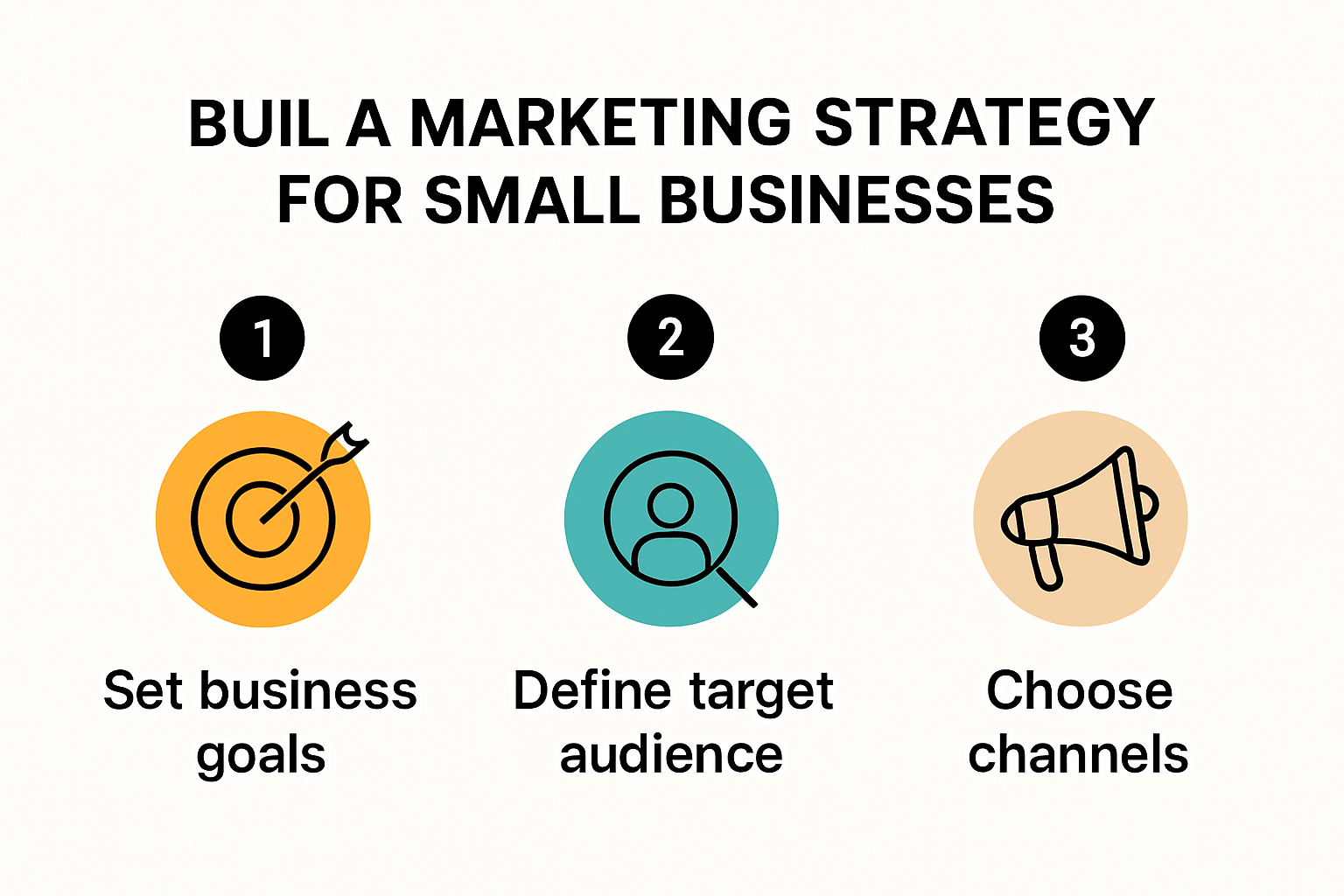Every small business wants a marketing strategy that actually works. So, you might expect high budgets or fancy tech are the only ways to get results. Surprisingly, research shows that senior marketers who define clear ‘north star’ KPIs can generate up to 70% higher revenue growth than their competitors. It turns out that building a winning strategy in 2025 is less about spending more, and more about knowing exactly who you speak to and what you measure.
Table of Contents
- Understanding Your Business Goals And Audience
- Choosing Digital Channels That Deliver Results
- Creating A Step-By-Step Marketing Plan
- Measuring Success And Adjusting Your Strategy
Quick Summary
| Takeaway | Explanation |
|---|---|
| Define Clear Business Goals | Establish specific, measurable marketing objectives that align with your overall business vision to guide effective marketing strategies. |
| Understand Your Target Audience | Conduct thorough audience research to identify demographic, behavioral, and psychographic characteristics, creating detailed buyer personas for targeted marketing. |
| Choose Appropriate Digital Channels | Select digital marketing channels strategically based on business objectives and audience preferences, ensuring a tailored approach for each platform. |
| Implement Performance Tracking | Regularly measure marketing performance using key performance indicators (KPIs) to inform strategy adjustments and ensure positive return on investment. |
| Adapt and Improve Continuously | Embrace ongoing learning and flexibility in your marketing strategies to respond to market changes, consumer behaviors, and technological advancements. |
Understanding Your Business Goals and Audience
Successful marketing begins with crystal clear understanding of your business objectives and the audience you aim to serve. Without this foundational knowledge, marketing efforts become scattered and ineffective.
Defining Clear Business Goals
Building a robust marketing strategy starts with precise goal setting. According to the U.S. Small Business Administration, entrepreneurs must establish specific, measurable marketing and sales objectives that align with their overall business vision.
Typical marketing goals might include:
- Brand Awareness: Increasing visibility and recognition in your target market
- Customer Acquisition: Growing your customer base through strategic outreach
- Revenue Generation: Driving sales and improving financial performance
Each goal requires a tailored approach. For instance, brand awareness might involve social media campaigns, while customer acquisition could demand more targeted digital advertising strategies.
Identifying and Understanding Your Target Audience
Harvard Business School emphasizes the critical importance of comprehensive audience research. This involves collecting detailed demographic information, analyzing consumer behavior patterns, and developing nuanced understanding of potential customer motivations.
Effective audience identification includes examining:
- Demographic Characteristics: Age, gender, income level, education
- Behavioral Insights: Purchasing habits, online interactions, preferences
- Psychographic Factors: Values, interests, lifestyle choices
Strathmore University Business School recommends creating detailed buyer personas. These fictional representations of ideal customers help businesses visualize and understand their target market more intimately.
For small businesses, this means moving beyond generic assumptions and developing a deep, empathetic understanding of who your customers truly are. This approach transforms marketing from a generic broadcast to a precise, targeted communication strategy.
Remember that audience understanding is not a one time exercise. Markets evolve, consumer preferences shift, and successful businesses continuously refine their understanding of their target demographic. Regular research, feedback collection, and market analysis become essential tools in maintaining marketing relevance.
By combining clear business goals with profound audience insights, small businesses can create marketing strategies that are not just effective, but transformative. Your marketing becomes a strategic asset, driving growth and building meaningful connections with your ideal customers.

Choosing Digital Channels That Deliver Results
In the rapidly evolving digital marketing ecosystem, selecting the right channels becomes crucial for small businesses seeking meaningful engagement and measurable results. Not all digital platforms deliver equal value, and strategic channel selection can significantly impact marketing effectiveness.
Understanding Digital Channel Diversity
Digital marketing channels have expanded dramatically, offering businesses multiple touchpoints for customer interaction. According to the University of Houston’s Small Business Development Center, artificial intelligence is transforming content creation and personalization across these channels, making strategic selection more nuanced than ever.
Key digital channels for small businesses include:
- Social Media Platforms: Facebook, Instagram, LinkedIn, TikTok
- Search Engine Marketing: Google Ads, Bing Ads
- Content Marketing: Blogs, YouTube, Podcasts
- Email Marketing: Targeted campaigns, newsletters
- Messaging Platforms: WhatsApp Business, Telegram
The critical factor is not being present everywhere, but being strategic and purposeful in channel selection. Each platform demands a unique approach tailored to its specific audience and interaction dynamics.

Matching Channels to Business Objectives
Effective channel selection requires alignment between your business goals and platform capabilities. Forbes Research indicates that businesses achieving the highest ROI carefully match channel characteristics with specific marketing objectives.
For instance:
- Brand awareness might prioritize visual platforms like Instagram
- Lead generation could focus on LinkedIn for B2B connections
- Direct sales might leverage Facebook and Google Ads
Understanding platform demographics becomes crucial. Different channels attract distinct user segments based on age, professional background, interests, and online behavior.
Small businesses must conduct thorough audience research to identify where their potential customers spend most of their digital time. This involves analyzing platform usage statistics, engagement rates, and conversion potential.
Data-Driven Channel Optimization
Successful digital marketing demands continuous monitoring and adaptation. Implement robust tracking mechanisms to measure channel performance through key metrics like engagement rate, click-through rate, conversion rate, and customer acquisition cost.
Modern digital marketing platforms offer sophisticated analytics that provide granular insights into campaign performance. These tools enable businesses to make informed decisions, reallocate resources, and refine strategies in real-time.
Remember that channel effectiveness is not static. Consumer preferences evolve, platform algorithms change, and new technologies emerge. Maintaining flexibility and a willingness to experiment becomes as important as initial channel selection.
By approaching digital channel selection as a strategic, data-informed process, small businesses can create marketing ecosystems that are not just responsive, but predictive and adaptive. The goal is creating meaningful digital conversations that transform casual interactions into lasting customer relationships.
Here’s a summary table showing how different digital marketing channels align with specific business objectives for small businesses:
| Channel Type | Example Platforms | Primary Business Objective |
|---|---|---|
| Social Media | Facebook, Instagram | Brand Awareness, Engagement |
| Search Engine Marketing | Google Ads, Bing Ads | Direct Sales, Lead Generation |
| Content Marketing | Blogs, YouTube, Podcasts | Brand Awareness, Engagement |
| Email Marketing | Newsletters, Targeted Emails | Customer Retention, Promotion |
| Messaging Platforms | WhatsApp Business, Telegram | Customer Support, Engagement |
Creating a Step-by-Step Marketing Plan
Transforming marketing goals into actionable strategies requires a systematic approach. A well-crafted marketing plan serves as a roadmap, guiding small businesses through complex digital marketing terrain with precision and purpose.
Establishing Clear Marketing Objectives
According to the U.S. Small Business Administration, developing a robust marketing plan starts with defining specific, measurable objectives. These goals should directly align with your broader business vision and provide a clear direction for your marketing efforts.
Key objectives might include:
- Quantifiable Growth Targets: Specific revenue or customer acquisition numbers
- Brand Positioning: Establishing market differentiation
- Customer Engagement: Increasing interaction and loyalty metrics
Each objective requires detailed breakdown. For instance, a growth target of 20% revenue increase needs specific strategies across marketing channels, budget allocations, and performance tracking mechanisms.
Strategic Marketing Tactics and Resource Allocation
The Arkansas Small Business and Technology Development Center emphasizes the importance of conducting thorough competitive analysis and understanding customer demographics. This research informs tactical decisions about marketing approaches and resource distribution.
Marketing resource allocation involves:
- Budget Planning: Determining financial investments across different channels
- Time Management: Scheduling content creation and campaign execution
- Skill Deployment: Matching team capabilities with marketing requirements
Explore our comprehensive guide on digital marketing strategy planning to understand how strategic planning can transform your marketing approach.
Performance Measurement and Continuous Optimization
Xero’s guide on small business marketing highlights the critical nature of performance tracking. Successful marketing plans are not static documents but dynamic frameworks that evolve based on real-world data and insights.
Effective performance measurement involves:
- Key Performance Indicators (KPIs): Establishing metrics like conversion rates, customer acquisition costs
- Regular Performance Reviews: Monthly or quarterly strategy assessments
- Adaptive Strategy: Willingness to pivot based on data-driven insights
Small businesses must view their marketing plan as a living document. Technology and consumer behaviors change rapidly, demanding continuous learning and strategic refinement.
Implementing a step-by-step marketing plan transforms marketing from a hit-or-miss activity into a structured, predictable business function. By combining clear objectives, strategic tactics, and rigorous performance tracking, small businesses can create marketing strategies that are not just reactive, but proactively driving business growth.
Below is a process table that outlines the key steps for building a small business marketing plan as described in the article:
| Step | Description |
|---|---|
| 1 | Define specific, measurable marketing objectives |
| 2 | Conduct audience and market research |
| 3 | Select appropriate digital channels based on audience & goals |
| 4 | Allocate resources (budget, time, skills) strategically |
| 5 | Execute campaigns and tactics across chosen channels |
| 6 | Measure performance using KPIs |
| 7 | Review, optimise, and adapt strategy based on data insights |
Measuring Success and Adjusting Your Strategy
Marketing success is not about implementing strategies blindly, but about continuous measurement, analysis, and strategic refinement. Small businesses must develop a robust framework for tracking performance and making data-driven decisions.
Identifying Key Performance Indicators (KPIs)
BCG research reveals that senior marketers who define clear ‘north star’ KPIs can generate up to 70% higher revenue growth compared to their competitors. These indicators provide a comprehensive view of marketing effectiveness beyond simple metrics.
Critical KPIs for small businesses include:
- Customer Acquisition Cost (CAC): Total marketing expenses divided by new customers acquired
- Conversion Rate: Percentage of potential customers completing desired actions
- Return on Marketing Investment (ROMI): Revenue generated compared to marketing expenditure
- Engagement Metrics: Social media interactions, website traffic, email open rates
Choosing the right KPIs requires understanding which metrics genuinely reflect business objectives. Not all measurements carry equal strategic significance.
Implementing Effective Performance Tracking
The U.S. Small Business Administration emphasizes comparing marketing and sales costs against generated revenue to ensure positive return on investment. This approach demands sophisticated tracking mechanisms and analytical tools.
Performance tracking strategies include:
- Regular Analytics Review: Monthly or quarterly comprehensive performance assessments
- Comparative Analysis: Benchmarking against industry standards and previous performance
- Segmented Performance Evaluation: Breaking down metrics by channel, campaign, and customer segment
Explore our digital marketing performance tracking solutions to understand how advanced analytics can transform your strategy.
Strategic Adaptation and Continuous Improvement
OpenStax’s entrepreneurship research highlights the necessity of using KPIs to evaluate marketing strategy effectiveness and facilitate strategic adjustments.
Successful strategic adaptation involves:
- Agile Methodology: Quick, data-informed strategy modifications
- Experimentation: Testing alternative approaches based on performance insights
- Continuous Learning: Creating a culture of ongoing strategy refinement
The most effective marketing strategies are not static but dynamic frameworks that evolve with market conditions, technological changes, and customer behaviors.
By implementing a rigorous measurement and adaptation process, small businesses transform marketing from a cost center into a strategic growth engine. The goal is not just tracking performance, but creating a responsive, intelligent marketing ecosystem that consistently delivers value.
Frequently Asked Questions
How can I define clear business goals for my marketing strategy?
To define clear business goals, identify specific, measurable objectives that align with your overall business vision. This includes setting targets for brand awareness, customer acquisition, and revenue generation.
What methods can I use to understand my target audience?
You can understand your target audience by conducting thorough market research, analyzing demographic and psychographic factors, and creating detailed buyer personas to visualize and understand their motivations and preferences.
Which digital marketing channels should I focus on?
Focus on digital marketing channels that align with your business objectives and audience preferences. Popular channels include social media platforms, search engine marketing, content marketing, email marketing, and messaging platforms.
How can I measure the success of my marketing strategy?
You can measure your marketing success by establishing key performance indicators (KPIs) that reflect your goals, tracking metrics such as customer acquisition cost and conversion rates, and regularly reviewing performance to make data-driven adjustments.
Transform Your 2025 Marketing Strategy Into Real Growth
Building a marketing plan is only the first step. Many small businesses struggle to set up accurate tracking, manage their campaigns, or choose the best channels like Google Ads, Meta Ads, or TikTok Ads. If you feel unsure about measuring your marketing success or making sense of performance data, you are not alone. The article highlighted how vital clear goals and continuous data-driven optimisation are for outpacing competitors.

Let Zoo Digital put your plan into action. Our team will help you set up seamless tracking, run high-performing digital campaigns, and automate critical processes with tools like WhatsApp bots and HubSpot CRM. Visit Zoo Digital today to see how our data driven approach can help your business adapt and thrive in 2025. Do not wait. Take the first step now and secure a marketing partner who delivers measurable results.
Recommended
- Zoo Digital – Digital Marketing Strategy & Planning
- Digital Marketing 2023 | Unlocking Growth with Zoo Digital
- Digital Strategy Archives – Zoo Digital
- Is it worth creating organic content? – Zoo Digital
- Content Marketing Strategies for Business Growth in 2025 | 12AM Agency
- Unlock The Power Of Ai: Marketing Tips For Small Business Owners

